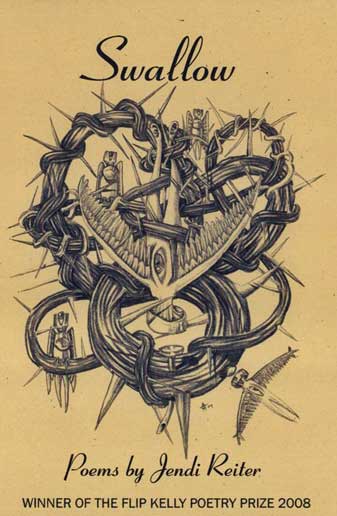As my attention span fades along with the light of summer days, I’m appreciating the brevity and variety that a good literary journal can offer. Here are some of the publications I’ve been enjoying this season:
Naugatuck River Review‘s summer 2009 issue is stuffed with good narrative poetry on themes including fathers and sons, aging, class and race, romance, miscarriages, Mexico, horses, D-Day flashbacks, and what happens when you’re in a bar with a woman who sees God. Read the issue from beginning to end because editor Lori Desrosiers has structured it like a narrative, with one theme segueing into the next. If you’re in Western Massachusetts this Tuesday night, come to the NRR authors’ reading at Spoken Word in Greenfield.
Think you know all there is to know about Huck Finn? The Missouri Review‘s summer 2009 issue includes a provocative essay by Andrew Levy, arguing that Twain’s book is not primarily about race but about our culture’s myths and fears concerning adolescent boys.
Issue #9 of Chroma, the UK-based queer literary journal, features a sestina by Judith Barrington, a hilarious and sad essay by trans-man Simon Croft about passing at a family funeral, and cover art by photographer Elisabeth Ohlson Wallin.
The most terrifying story ever written appears in Barrelhouse Issue #7. Critics may disagree about which one this is. Matt Williamson’s “Sacrament”, a war-on-terror dystopia that makes Guantanamo look tame, is vying for supremacy with Matt Bell’s “BeautyForever”, a George Saunders-esque tale of love in the time of pharmaceuticals.
Finally, two online prose offerings for your free instant gratification. Gemini Magazine is a newly launched e-zine that publishes flash fiction, short stories, poetry, and drama. So far, my favorite piece in the September issue is Mary J. Daley’s “Wayward Conception”, a lingering, beautifully textured story about a young mother overwhelmed by the choices she’s made:
Stacy forgot about the baby, concentrating solely on the sunlight thatreflected off the stainless steel pot between her feet. The contrast of itsshine against the dull and worn porch steps had lulled her into a void,where her baby, so new and minuscule within her, slipped from herthoughts entirely and blissfully.
A plastic bag of green beans almost a quarter full sat beside her cup of milkytea. The beginning of a burn crept across her bare shoulders as she tookher time, cutting delicately, pressing green skin between thumb and knifeblade. She found this unhurried quiet elegant and she willed herself tostretch it out, to forget the stuffy heat of the house, the needs of thechildren and for one blessed moment the coming baby.
The rattling motor of Tommy’s black Ford broke apart her short-lived escapeand she raised her head, shielding her eyes from the onslaught of sunshineas he pulled into the gravel driveway. As he slid his big frame from the cab,she lowered her sight to his work boots. They came towards her crunchingloudly on the small white rocks.
“You’re home early?” she asked, squinting her green eyes, trying to avoidthe sun’s spillage around him.
“I have a job at the church and I need my safety harness.”
He jogged up the steps two at a time, disappearing into the porch just toreappear a minute later with the harness in his huge hands. He smelled ofpaint and turpentine.
“Does it pay?” she asked.
He nodded, pausing beside her for a second to consider what else he mightrequire. She waited, looking at his hands that held the belt, his short nails,the yellow stains of nicotine between index and middle finger, the ampleblue veins running beneath the skin.
“Did you finish up at Emily’s?”
“Almost. She’s not happy with the color in the dining room, but she’s willingto live with it for a few days to see if it grows on her.” He gingerly steppedover the teacup, not looking at his wife.
“God Tommy, I need to get groceries. She didn’t pay you, did she?” Stacysighed knowing full well Emily wouldn’t part with a dime until she wascompletely and whole-heartedly satisfied with the job.
“I’ll have it finished by Monday.”
“What are you doing at the church?”
He stopped at the truck, one hand reaching for the handle. She could seethe self-importance subtly emerge. After seven years of marriage she knewthe signs: shoulders pulled back ever so slightly, the first traces of red alongthe indentations of his neck, the minute lowering of voice as he answered.“The lights in the cross need to be replaced but Joe hurt his back. I said Iwould do it. Shouldn’t be too long.”
She gaped at him, wide eyed, mouth opened as he climbed back up into thetruck. Raising her voice over the sound of the ignition trying to turn over,she called. “Tommy, you’re not telling me you’re going to climb to the verytop of that steeple?”
“What? Are you saying I can’t?” He leaned slightly out the side windowwhile he gave the truck a chance to rest before turning the ignition overagain.
She shook her head and said, “No, just that it’s dangerous! Isn’t?”
“Should be easy to figure it all out once I’m up there.” He flashed a smilewhen the motor started. Tommy had a prominent chin and tiny eyes and asthe years went by it was only his confident smile that kept him from crossingthe line into unappealing. He turned his head to check for non-existenttraffic, backed the truck from the yard and was gone.
Fool, she thought as she tossed a bean into the pot. Just like Tommy andhis constant display of bravado to take that job, leaving Emily to mull overher walls and her to worry about what to do for meals. God she hoped hefell.
…
Read the rest here.
For something completely different, check out the experimental poetry and prose journal DIAGRAM, Issue 9.4. Highlights include Rhoads Stevens’ “Who Does What to Whom”, a bizarre Punch-and-Judy show personifying various phrases in a quote from Noam Chomsky’s Syntactic Structures, “a book that’s never been read while a patient waits for a barium enema.”

